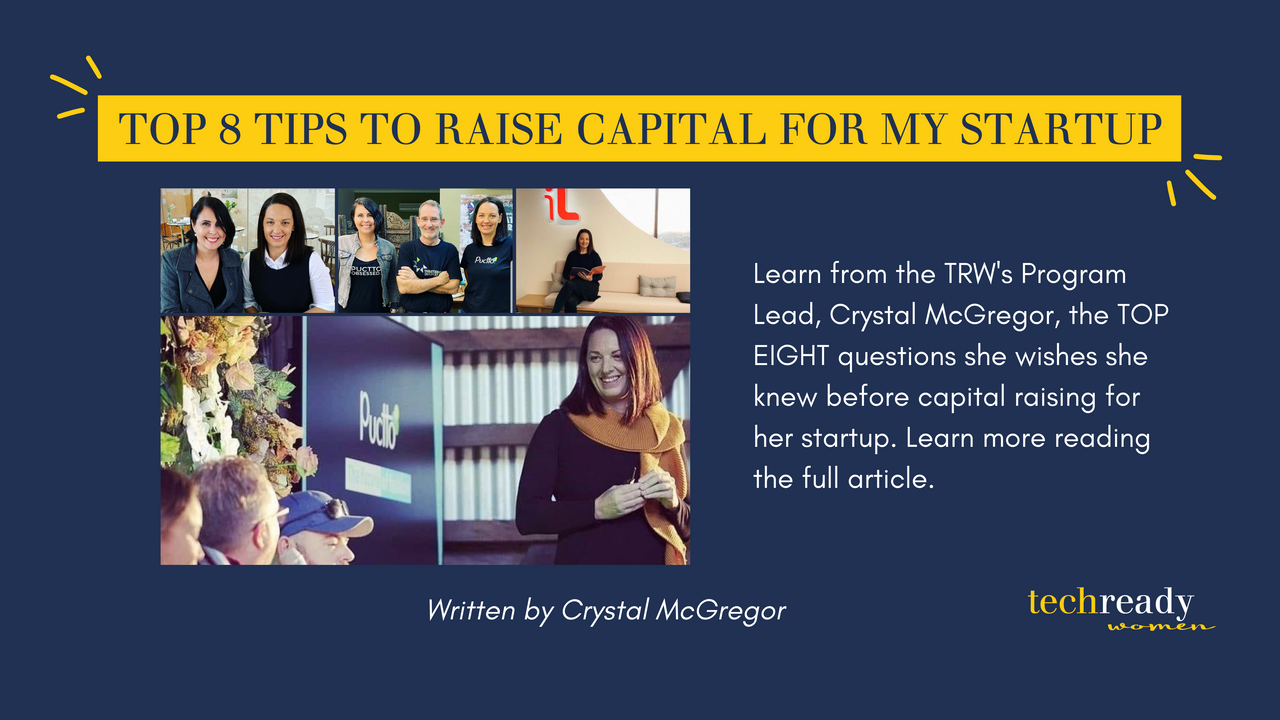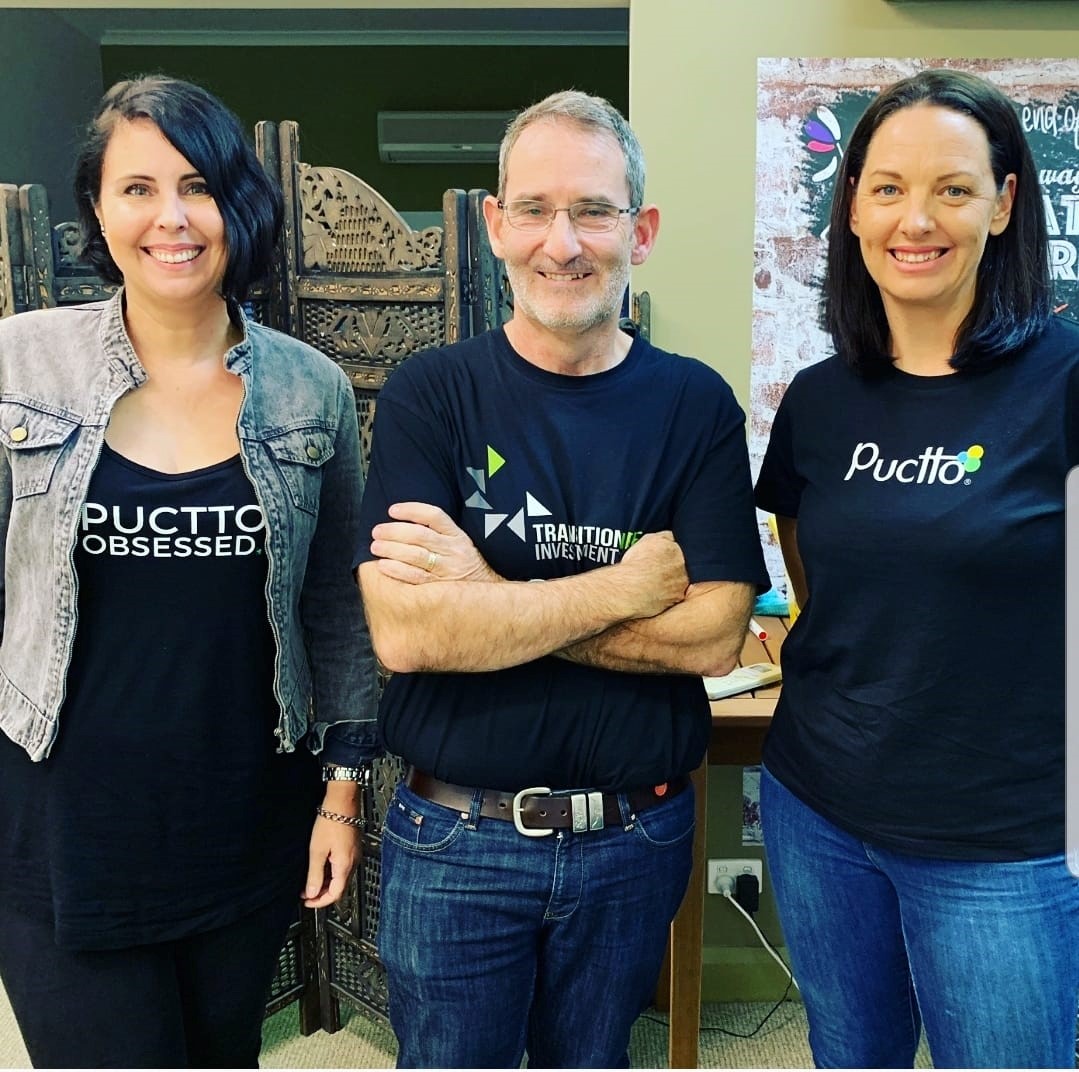Robust Theme
Dec 09, 2019 2020-04-08 7:40Robust Theme
TOP 8 TIPS TO RAISE CAPITAL FOR YOUR STARTUP

Are you looking to raise capital for your startup and not sure where to start?
Tech Ready Women’s Program Lead, Crystal McGregor, shares the TOP EIGHT things she wishes she knew before capital raising for her startup.
Crystal begins “I’m often asked to jump on a quick call and talk about raising capital, as a female founder. The conversations are never quick, but I love the opportunity to help another woman to take the next step up the ladder.”
Crystal’s TOP EIGHT shares:
1. ARE WE READY?
Before starting the investment journey, we needed to be able to clearly articulate the problem and solution; have tested that solution with some sort of success (testers, users, revenue, feedback); have an idea of a business model (how we would make money) and have a company structure suitable for investment. IF ONLY I had known about the TRW Investment Ready Program!
The key here is to file all of the super important information that you might want to share with potential investors in one file (often called a ‘Data Room’). The Data Room should be consistent in messaging and kept up-to-date. This will be where you access your documents in the due diligence process.
2. ARE WE PITCH READY?
The next step is to articulate your story into a pitch… ERR should I say many pitches. There’s the elevator pitch (30-second verbal pitch); a 3-5 minute presentation with accompanying slides; a 10-minute presentation with slides and questions; a 10-slide deck to email, with no presentation; and perhaps a longer document with full details.
The key here again is to have consistency across your pitch decks, think about who the audience is and what they need from you. Keep your updated pitch decks in your Data Room.

3. WHERE DO WE FIND INVESTORS?
Start talking - to anyone and everyone! ‘Family Friends and Fools’ (FFF) are a great place to start the capital raising journey. Start the conversation with your mentors, advisors and people in industry. Not only do you get the chance to practice your pitch, they can also lead to beautifully warm introductions.
Pitch events are also a great way to get ‘found’ and have people talking about you and your startup. There’s also prizes and subscription credits on offer…startups love free stuff, right!
Airtree have collated a comprehensive Investor List - for fundraising in Australia. It’s worth having a look at who all the players are and who might be a good fit for your startup.
Gust is a platform that many Australian Angel Groups use to vet startups. It’s FREE to create a profile and upload all of your company information, then you can give access to investor groups through their application process.

4. HOW CAN I PITCH WITHOUT BEING NERVOUS?
Potential investors often give advice (some helpful, some not), but I remember one investor saying to me “Crystal, I want you to keep pitching until you just don’t care anymore!”.
At the time, I thought what a bizarre thing to say. It was only when I was about 50 pitches in and so over it that I realised. I wasn’t daunted by who I was pitching to, I knew my content inside out and that is the level of confidence investors want.
Yes, pitching is outside of the comfort zone for many of us, finding a way to get comfortable is the trick here.

5. I’VE PITCHED - NOW WHAT?
Unless you’re super lucky or you’re riding an unidentified unicorn, you won’t get an offer for investment from your first pitch. It takes time to build trust and understanding. Investor Updates are a great way to show potential investors your growth, more about who you are, what is happening in your startup and the industry, as well as your ASK.
While capital raising, releasing an Investor Update every 2-3 months will keep you front of mind. Think METRICS, METRICS, METRICS - showing real and continual growth in numbers is exciting. And remember to keep updating your own Investor Database with how each investor responded to your update or pitch. Keeping a record of frequently asked questions and answers is also a huge time saver, that in the future you will be thankful for.
6. HOW LONG IS THIS GOING TO TAKE?
For many of us the investment process took way longer and was way more difficult to achieve, than expected.
You might have been asked ‘Do you really need investment?’ and ‘What if you put the same amount of effort into getting traction with paying customers?’. I would suggest you think really hard about these two questions.
Imagine for a moment, taking at least 50% of your energy over the next 12-18 months chasing investment (I’m not sure if this is the worst or best case scenario, just a common response when I ask other Founders). Then ask yourself “What IS my level of commitment to capital raising versus getting more paying customers?”.
7. FINALLY, SOME INTEREST - ARE YOU THE RIGHT INVESTOR?
You may have investors that like the opportunity you are presenting, but with any good relationship, the feeling should be mutual. There are countless stories about what can go wrong, but also many stories of great relationships and startup successes. The investor will be part of the decision-making process for your business moving forward, keep that in mind more so than the money they’re investing.
Think about how you make decisions - is it gut instinct you listen to? Like to have another opinion? Need to get all the T’s crossed and I’s dotted? - Perhaps all of the above.
The terms of the investment will be set out in your shareholder agreement. Even if you don’t like reading legal documents, it’s really important that you fully understand the terms of investment. This will be your first point of reference, if something goes wrong.

8. WHAT’S MY VALUATION?
You will definitely be asked this before getting to the signing stage, but your valuation could be negotiated up until signing on the dotted line. Working out a valuation for a startup is like ‘how long is a piece of string?’.
Just like your ‘hockey stick’ financial growth curve, it’s not really the numbers, but more the story behind the numbers. Does the story make sense? Is the story consistent across the business (i.e. marketing strategy, sales forecasts, revenue projections)? And does it align with what investors already know to be true?.
Again, there are numerous tools out there to determine startup valuation. In the end, it’s really up to the value both you and your investors are willing to settle on.
Overwhelmed yet? We are.
Feel free to jump back in and use this blog as your guide and as usual the Tech Ready Women Team are here to support you in your startup journey.
Good luck with the capital raising process and remember to savour and CELEBRATE THE WINS! 🎉
Written by Crystal McGregor - TRW Program Lead

